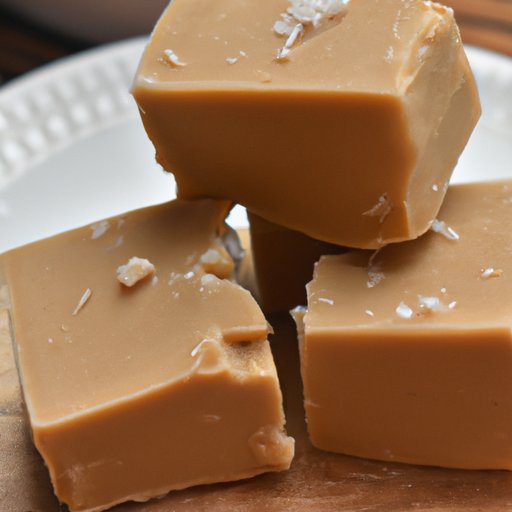I. Introduction
Old-fashioned fudge is a classic and beloved treat that has been enjoyed by generations. Its rich flavor and creamy texture make it a favorite at parties, gatherings, and as a special treat. Despite its popularity, many people find it challenging to make perfect fudge. In this guide, we will explore how to make old-fashioned fudge from scratch and provide helpful tips and ideas for all levels of home chefs.
II. Step-by-Step Guide
To make old-fashioned fudge, you will need some basic ingredients such as sugar, milk, butter and vanilla extract. Following the right process and tips while measuring the ingredients, stirring the mixture accompanied by right temperature will make the perfect fudge with the right texture and flavor. It is important to use a candy thermometer to check the temperature of the mixture frequently. Here is a step-by-step guide:
- Combine sugar, milk, and butter in a saucepan and heat over medium heat, stirring constantly.
- Once the mixture comes to a boil, stop stirring and carefully clip a candy thermometer to the side of the pot. Let the mixture boil until it reaches 238°F (or soft ball stage) on the thermometer.
- Remove the pot from heat and add in your chosen flavorings (such as vanilla extract).
- Allow the mixture to cool to 110°F and beat the mixture with a wooden spoon or an electric mixer for 5-10 minutes (until the mixture thickens and begins to lose its gloss).
- Pour the mixture into a greased pan and let it cool and harden.
- Cut it into small squares and enjoy!
This may seem like a simple process, but there are tips and tricks that can make the difference between perfect fudge and a recipe gone wrong. For example, be sure to measure your ingredients carefully and never stir the mixture after it reaches boiling point. In addition, be sure to beat the mixture correctly to achieve that creamy, yet firm texture.
III. Historic Context
The origins of fudge can be traced back to the late 19th century and it became a popular treat in America during the 20th century. Traditional recipes have been adapted over time which made fudge a versatile treat. Its cultural significance is valuable to many families and communities, it is not only a sweet treat but it is also a medium for sharing memories, connections and traditions. Historians say that fudge was originally created by mistake by a college professor who didn’t want to throw away a botched batch of caramel. Since then, fudge has become a beloved and iconic treat that has been passed down through generations.
IV. Personal Storytelling
Fudge has been a significant treat in many families. It has become a part of traditions and memories. Do you have a personal story associated with a family recipe? It doesn’t have to be specifically about fudge-making, it could be about the ingredients or occasions that you’ve shared while eating fudge. Sharing those stories is very important in preserving the memories and connections that are attached to it. Emphasize how a single recipe connects people and memories from different generations. It can also serve as a perfect way to introduce newcomers to the recipe and its cultural background.
V. Modification Guide
Fudge is typically made with sugar, milk, and butter, but there are ways to modify the recipe to accommodate different dietary needs or preferences. For example:
- To make gluten-free fudge, substitute gluten-free corn syrup or honey for the corn syrup, and use gluten-free vanilla extract and chocolate chips.
- To make vegan fudge, use a vegan butter substitute and a plant-based milk (such as almond milk or soy milk).
- To make low-sugar fudge, use a sugar substitute such as erythritol or stevia, or reduce the amount of sugar needed and replace by stevia or any other natural sweeteners.
Each modification will change the taste and texture of the final product, so experiment to find the perfect balance. Sometimes exclusions lead to unique flavoring. Nutrition value could also be considered while making these adjustments.
VI. Variation Showcase
If you enjoy the basics of old-fashioned fudge, you can add varied flavors, nuts, and marshmallows to create mouthwatering variations. Changes such as substituting the regular vanilla extract to almond or peppermint extract can also do the trick. Here are a few popular variations to try:
- Rocky Road fudge: includes marshmallows and walnuts, a perfect sweet and crunchy combination.
- Chocolate peanut butter fudge: a savory and sweet mix of chocolates and peanut butter, perfect if you love a more flavorful taste.
- Cinnamon fudge: adds cinnamon for a cozy and warm flavor with a slight kick to it.
With so many variations possible, it is worth experimenting and finding favorite ones. Each flavor can make the perfect holiday treat for those who love special and unique sweets.
VII. Visuals-Focused Article
This type of article is great for visual learners, as it provides step-by-step images that show the process of making fudge in detail. Keep in mind that if visuals are used as the main focus of the article, the use of videos or GIFs could also be a great addition. Remember to define the recipe, but give more focus on the visuals to provide easier comprehension.
VIII. Conclusion
Making old-fashioned fudge may seem daunting at first, but with the proper guidance and helpful tips, anyone can create delicious and creamy fudge at home. Whether you want to explore variations, learn its cultural significance or make adjustments to conform to your dietary needs, this guide will provide you with the necessary information to create the perfect fudge.
(Note: Is this article not meeting your expectations? Do you have knowledge or insights to share? Unlock new opportunities and expand your reach by joining our authors team. Click Registration to join us and share your expertise with our readers.)
